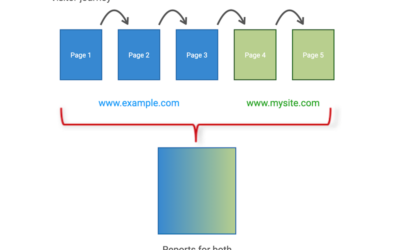![]() Urchin is the software company and technology that Google acquired in April 2005 that went on to become Google Analytics. Urchin software remains a product in its own right and is a downloadable software tool that runs on a local server (Unix and Windows) providing web analytics reports by processing web server logfiles – including HYBRID logfiles – which are the most accurate.
Urchin is the software company and technology that Google acquired in April 2005 that went on to become Google Analytics. Urchin software remains a product in its own right and is a downloadable software tool that runs on a local server (Unix and Windows) providing web analytics reports by processing web server logfiles – including HYBRID logfiles – which are the most accurate.
Although not as feature rich as Google Analytics, Urchin is essentially the same technology that allows you to view historical data over any time period you have data for, as well as providing complimentary information not available in Google Analytics.
Data available in the latest Urchin beta release that Google Analytics does not have:
(click for screenshots – opens new window)
- Error page/Status code reports
- Bandwidth reports
- Login name reports – standard Apache .htaccess or any authentication that logs usernames in the logfile
- Visitor history report – tracking individual visitors (anonymously)
- Greater customisation – show as much or as little data as you want
- Data is stored locally on your server in a mysql database – allows for ad-hoc data queries
Reporting differences between Google Analytics and Urchin beta software:
- GA imports AdWords cost data with little fuss
Just just two tick boxes to click and the data is collected daily. For Urchin, this is a manual process - The GA dashboard is fully customisable
With up to 12 different reports that can be changed and re-ordered on a per user basis. Urchin summary dashboards are fixed - GA geographic overlay is best in class
With zoom and continent/subcontinent breakdown, this GA report is one of the best out there. Urchin geographic overlay is a little more basic (same as GA v1.0), though still very good - GA is available in 25 languages, Urchin is available in 12
- GA has internal site search reports, Urchin does not
- GA has event tracking (beta), Urchin does not
Should I use Urchin or Google Analytics?
Historically I am very attached to the Urchin product. After ‘discovering’ it by chance in 2003, I have never looked back – following the writing of an article at the time evangelising what a breath of fresh air Urchin was compared to WebTrends and Sawmill products, my former company became the first UK Partner for Urchin which later led to my recruitment by Google. So believe me when I say, I love the product. And with the announcement at e-Metrics in Washington of the upgraded Urchin software, the product just got a whole lot better.
Google Analytics is free – Urchin software is not. However Urchin has some real advantages over GA. For example, data is recorded and stored by your web server rather than streamed to Google, which means that you can:
- Keep and view data for as long as you wish
– Google Analytics currently commits to keeping data for a minimum 25 months* - Have your data audited by an independent third party such as ABCE
– Google Analytics does not pass data to any third party - Reprocess data when you wish – for example, to apply a filter retroactively
– Google Analytics currently does not reprocess data retroactively - Works behind the firewall i.e. suitable for Intranets
– Google Analytics can not run behind a closed firewall
Of course Urchin’s functionality comes at a price – not just in purchasing the software (which is actually inexpensive though the latest Urchin pricing has yet to be announced), but more in terms of the IT overhead required to maintain and archive logfile data that can become very large, very quickly – as a guide, every 1,000 visitors produces approximately 4Mb of log info.
Criteria to select GA or Urchin:
- If you have an Intranet site – use Urchin software. GA is a hosted solution and needs access to the Internet in order to work
- If you measuring a web site – use GA. Google Analytics is much easier to implement and maintain and is virtually maintenance free
- Use BOTH – if you need the flexibility of maintaining your own web visitor data (and have the resource to manage it). Combining GA with Urchin gives you the best of both worlds – the advanced features of GA (for free) and the flexibility of Urchin. The following article describes how you can run products side by side – Backup your GA data locally .
[*Google have made no attempt to remove data older than 25 months old.
**Urchin is sold and supported exclusively via Google Analytics Authorised Consultants (GAACs).]
Are you currently using Urchin 5.7, have you tried the new beta? Would you like to see more GA features incorporated into Urchin and if so, which ones? Please add your feedback via a comment.



We use urchin in all of our pages, however it makes it difficult if you have some sites in a non-template format which adding it to every individual page for tracking. With templat sites you add it on to 1 page and it goes on the footer of them all. Use footers people! Good for tracking campaigns. Example of a template and non-template site:
http://www.pearl-scan.co.uk
http://www.4document-scanning.co.uk
Hi Brian.
Another question for your goodself on the subject of Google Anayltics vs Urchin.
I see that this blog piece is a summary of the points you cover off in Chapter 3 of your (excellent) book. However, I wonder if you could add a bit more clarity in terms of whether Urchin and/or Google Analytics can cross-tabulate site activity metrics with a visitor’s personal details – by which I mean data capture that’s volunteered on registering to the site.
Say for instance, we have a file download as a site goal, could Urchin and Google Anayltics both support a breadout of this measure by, for instance, the registered user’s employment category?
Is it this sort of functionality that you speak to when referencing “Login name reports”?
A bit uncertain as to what extent the registered user info that’s been captured can be utilised to better understand precisely what audience (as defined by the site’s own reg user data capture) is looking at what content/achieving what goals. And whether this sort of functionality is supported by just Urchin, or by Google Anayltics too, or only by a combination of the two.
Many thanks.
Brian,
Agreed. utm_override solves my problem partially – it tells how many of those campaign visitors eventually converted. I’d also like to know if they visited the site again.
I can think of using session labeling (utmv) to accomplish this. On the landing page (assuming it is dedicated to that campaign) I can label the cookies appropriately and see their behavior there on. But there is a limitation in using this facility as you agree. Improper or too much usage of labeling might mess up the data. Are there any better/smarter ways of doing this in GA?
I’m referring to Visual Sciences in my earlier organization that allowed me to do this. I could segment the visitors (essentially cookies) and study their behavior over a period of time.
Thanks Brian!
Kiran
Kiran: I think what you are referring to is the overwriting of referral sources that GA/Urchin does by default i.e. the last referrer overwrites the previous one unless it is “direct” – direct typing of a URL, bookmark, or even a non-tagged email campaign.
The parameter you need to set in your campaigns is utm_nooverride. Have a look at Chapter 9 of the book for a fuller description – Changing the Referrer Credited for a Converison.
Hi Brian! Great article! I have a special requirement that I’m afraid neither GA nor Urchin would be able to solve. Also some of the paid leading tools like Omni don’t have a direct solution for this. I need your help!
My requirement: I run a brand marketing campaign say for 1 month. This campaign ran across display advertising, PPC search and also Email. With the current tools I can find out exactly how many visitors came thro these campaigns and how many are first-time visitors among those.
Now, I want to track the future interaction of this specific set of visitors with my site. How many of them came back and when. How many purchased my products in their subsequent visits. This helps me assess the true impact of my campaign.
Is there any way to do this using Urchin?
Cheers
Kiran
Excellent post, Brian! I agree that having both technologies: Google Analytics and Urchin gives you the most amount of flexibility for analyzing your web preference and I often get questions about the differences, strengths and weaknesses… Glad to see it all laid on the table 🙂
I notice only one flaw: Urchin doesn’t store data in a MySQL database. As much as I (and many other Urchin users) would love this to be true, Urchin (v. 5 and Beta v. 6) both still use a proprietary database to store reporting data, which makes ad-hoc queries a bit more limited, since you have to use Urchin-developed tools rather than the more flexible SQL tools.
Aaah! Thank you! That’s exactly the information that I was looking for.
Ernesto